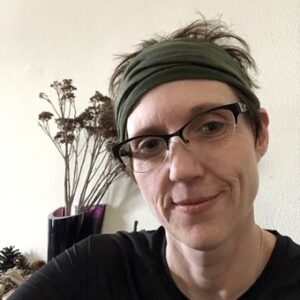
Stephanie Morrissette
Stephanie is an avid naturalist and a Library Assistant in the Adult Services Department at CDPL.
The Library Naturalist will lead a Pioneer Plant History Hike at Brickyard Nature Park (759 Concord Road) on Saturday, May 17 at 10 am. We will meet in the parking lot before beginning our hike. As we enter the woods, we will look for (mostly) native, ephemeral wildflowers to identify, and then discuss important characteristics as well as historical ethnobotanical culinary uses.
We will also discuss wildflower mimics, which are plants that resemble other plants. These take a deeper knowledge of understanding to separate and identify them from similar species. Do you know Solomon’s Seal from False Solomon’s Seal? What were the commercial uses for Bloodroot? How did Liverwort get its name? Why was Cut-Leaf Toothwort called Crow’s foot or why was the Mayapple dubbed Mandrake root? Wildflowers are so diverse and their methods of attracting pollinators have adapted them to use many different kinds of birds and bugs to distribute seed and pollen. Did you know sweat bees, various flies, and beetles are major pollinators for the unique Bloodroot plant? These rancid-smelling, low-growing, dull flowers make this plant an interesting find, but can you see the flower, or is it camouflaged to protect it from potential predators? If you have these questions and more, our Library Naturalist should be able to field most questions you may have.
At the program, we will have a copy of “Wildflowers and Ferns of Indiana Forests” by Indiana’s own Michael Homoya to giveaway! It will aid you in all your future native plant identification and is a book to truly treasure. If you don’t win the giveaway, you can always borrow CDPL’s copy of Mr. Homoya’s book (635.9 Hom). I highly recommend this title. We also have several other wildflower guides in our collection, including “North American Wildflowers” by Barbara Burn (582.1309 Bur), “Wildflowers of North America” by the National Audubon Society (582.13097 Wil), and “Field Guide to Indiana Wildflowers” by Kay Yatskievych (582.13 Yat). Also available are the “National Wildlife Federation Field Guide to Wildflowers of North America” by David Brandenberg (582.13 Bra), and “Newcomb’s Wildflower Guide” by Lawrence Newcomb (582.13 New). For more historical information on wildflowers, you might be interested in “Hedgemaids and Fairy Candles: The Lives and Lore of American Wildflowers” by Jack Sanders (582.13 San).
If you prefer to learn more about home landscaping with native plants, I suggest exploring several titles from our collection, including “Bringing Nature Home: How You Can Sustain Wildlife with Native Plants” by Douglas Tallamy (639.9 Tal), “How to Create a Wildlife Garden” by Christine Lavelle (635.967 Lav), and “Pollinator Friendly Gardening: Gardening for Bees, Butterflies, and Other Pollinators” by Rhonda Hayes (638.5789 Hay). I also recommend “New Naturalism: Designing and Planting a Resilient, Ecologically Vibrant Home Garden” by Kelly Norris (635.9 Nor) for a great overview of how to begin to plan your native wildflower garden.
For more in-depth information on the wildflowers of Indiana, please join us for this interesting spring hike. The Library Naturalist will be happy to answer any questions you may have. A participation waiver is required before the program begins; please arrive a few minutes early to sign the form. If you need more information before the program, you can contact the Adult Services Department at 765-362-2242, ext. 3, or email smorrissette@crawfordsvillelibrary.in.gov. The library is open Monday through Thursday from 9 am until 9 pm; Friday and Saturday from 9 am to 5 pm; Sunday from 1 pm to 5 pm.
